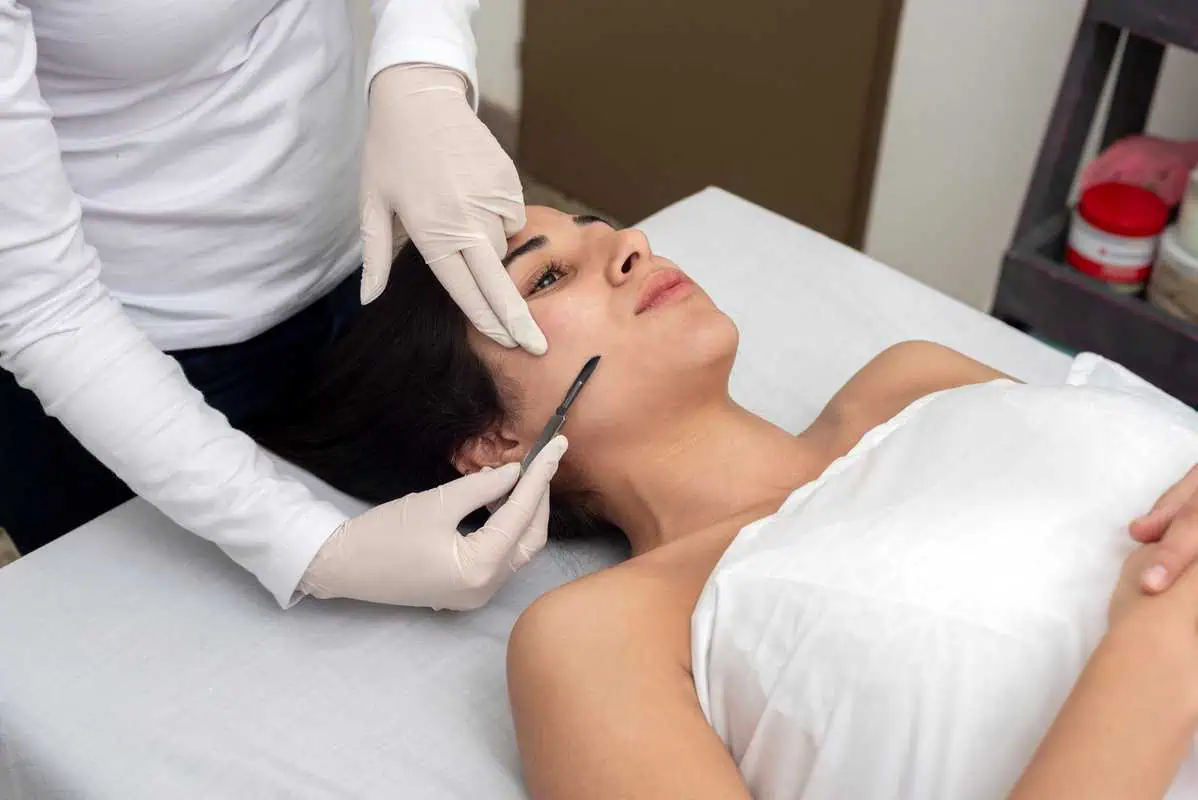
In the ever-evolving world of skincare, two popular exfoliation treatments have gained significant attention: dermaplaning and microdermabrasion. Both promise to reveal smoother, brighter skin, but they work in distinctly different ways. At The Art of Skin Dermatology, we believe in empowering our clients with knowledge to make informed decisions about their skincare. In this comprehensive guide, we’ll explore the intricacies of both treatments to help you determine which might be the right choice for your unique skin needs.
Understanding Dermaplaning
Dermaplaning is a physical exfoliation technique that uses a sterile surgical scalpel to gently scrape off the top layer of dead skin cells and fine vellus hair (peach fuzz) from the face.
How Dermaplaning Works:
- The skin is cleansed and dried thoroughly.
- A trained aesthetician or dermatologist holds the skin taut and uses a sterile 10-gauge scalpel at a 45-degree angle to gently scrape the skin’s surface.
- The blade is moved in short, swift strokes across the face, avoiding active acne, moles, and other raised lesions.
- After the treatment, a soothing serum or moisturizer is applied to the skin.
Benefits of Dermaplaning
- Immediate Results: Skin feels smoother and looks brighter instantly.
- Hair Removal: Removes fine facial hair, which can make makeup application smoother.
- Enhanced Product Absorption: By removing the barrier of dead skin and hair, skincare products can penetrate more effectively.
- Gentle Exfoliation: Suitable for most skin types, including sensitive skin.
- No Downtime: Patients can resume normal activities immediately.
Understanding Microdermabrasion
Microdermabrasion is a mechanical exfoliation technique that uses tiny crystals or a diamond-tipped wand to remove dead skin cells and stimulate collagen production.
How Microdermabrasion Works:
- The skin is cleansed and prepared for treatment.
- A handheld device either sprays fine crystals onto the skin or uses a diamond-tipped wand to gently abrade the skin’s surface.
- The device simultaneously suctions away dead skin cells and used crystals.
- The treatment is typically followed by the application of moisturizer and sunscreen.
Benefits of Microdermabrasion:
- Improved Skin Texture: Helps smooth rough skin and reduces the appearance of fine lines.
- Skin Brightening: Removes dull, dead skin cells to reveal brighter skin underneath.
- Pore Size Reduction: Can help unclog and minimize the appearance of enlarged pores.
- Collagen Stimulation: The exfoliation process can stimulate collagen production over time.
- Versatility: Can be used on various skin types and body areas.
Comparing Effectiveness
Both dermaplaning and microdermabrasion can be effective for improving skin texture and appearance, but they excel in different areas:
Dermaplaning
- Superior for removing fine facial hair
- Provides immediate smoothness and glow
- Excellent for creating a smooth canvas for makeup application
Microdermabrasion
- More effective for addressing deeper textural issues like fine lines and acne scars
- Better for unclogging pores and addressing blackheads
- Can be more beneficial for stimulating long-term collagen production
Suitability for Different Skin Types and Concerns
Choosing between dermaplaning and microdermabrasion often depends on your specific skin type and concerns:
Dermaplaning is generally better for:
- Sensitive skin
- Dry or dehydrated skin
- Those concerned about facial hair
- Pregnant women (as it doesn’t involve any chemicals)
Microdermabrasion may be preferable for:
- Oily or acne-prone skin (except active breakouts)
- Those with sun damage or hyperpigmentation
- Individuals with fine lines or shallow acne scars
- Those looking for more intensive exfoliation
It’s important to note that neither treatment is recommended for those with active acne, rosacea, or very sensitive skin conditions like eczema without consulting a dermatologist first.
Comparing the Treatment Experience
The experience of undergoing dermaplaning versus microdermabrasion can differ significantly:
Dermaplaning
- Generally painless, often described as a light scraping sensation
- Takes about 30-40 minutes
- No noise from machines
- Can be performed more frequently (every 3-4 weeks)
Microdermabrasion
- May cause a mild scratching sensation
- Takes about 30-60 minutes
- Involves noise from the machine
- Typically performed every 2-4 weeks for a series of treatments
Recovery and Aftercare
Both treatments are known for their minimal downtime, but there are some differences in recovery and aftercare:
Dermaplaning
- No downtime; patients can apply makeup immediately if desired
- Skin may feel slightly sensitive for a day
- Important to protect skin from sun exposure
- Avoid harsh skincare products for a few days
Microdermabrasion
- Minimal downtime; skin may be pink for a few hours
- Might experience mild swelling or sensitivity for 1-2 days
- Crucial to apply sunscreen and avoid direct sun exposure
- Should avoid exfoliating products for several days post-treatment
Long-Term Results and Maintenance
When considering which treatment to choose, it’s important to think about long-term results and maintenance requirements:
Dermaplaning
- Results are immediate but temporary, lasting about 3-4 weeks
- Regular treatments can lead to smoother, brighter skin over time
- No cumulative effect on collagen production
Microdermabrasion
- Results build over time with multiple treatments
- Can have a cumulative effect on collagen production and skin texture
- Maintenance treatments every 1-2 months are often recommended for optimal results
Combining Treatments
It’s worth noting that dermaplaning and microdermabrasion are not mutually exclusive. In fact, some patients benefit from alternating between the two treatments or even combining them in a single session. This approach can provide the benefits of both hair removal and deeper exfoliation. However, the suitability of combining treatments should be determined by a skincare professional based on your individual skin needs and goals.
Making Your Decision
Choosing between dermaplaning and microdermabrasion ultimately depends on your skin type, concerns, and desired outcomes. Here are some final considerations:
Choose Dermaplaning if:
- You’re primarily concerned with facial hair and surface-level dead skin
- You have sensitive skin that might not tolerate microdermabrasion
- You’re looking for an immediate glow with no downtime
Choose Microdermabrasion if:
- You’re targeting issues like fine lines, shallow scarring, or sun damage
- You have oily or acne-prone skin (but not active breakouts)
- You’re looking for a treatment that can stimulate collagen production over time
The Importance of Professional Consultation
At The Art of Skin Dermatology, we strongly recommend a professional consultation before deciding on any skincare treatment. Our experienced dermatologists and aestheticians can:
- Assess your skin type and concerns in person
- Discuss your skincare goals and expectations
- Recommend the most suitable treatment or combination of treatments
- Provide a customized skincare plan to complement your in-office treatments
Experience The Art of Skin Dermatology Today!
Both dermaplaning and microdermabrasion offer unique benefits for skin rejuvenation and can be valuable additions to your skincare routine. The “right” choice depends on your individual skin type, concerns, and aesthetic goals. At The Art of Skin Dermatology, we’re committed to helping you achieve your best skin through personalized treatment plans that may include dermaplaning, microdermabrasion, or a combination of therapies tailored to your needs.
Remember, consistent skincare goes beyond in-office treatments. Maintaining a good at-home routine with appropriate cleansing, moisturizing, and sun protection is crucial for long-lasting results. We invite you to schedule a consultation with us to explore your options and develop a comprehensive skincare strategy that will help you achieve and maintain the healthy, glowing skin you desire.




